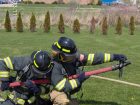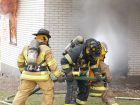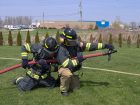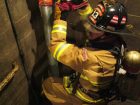
Features
Training
Back to Basics: May 2018
Continuing our look back over the last 10 years of Back to Basics in Fire Fighting in Canada, I’d like to highlight this article, which focuses on the backup person position on the handline. This position used to be simply ignored outside of basic training. Instructors like Aaron Fields, Dave McGrail and many others from across America started to bring the focus back to this important role.
April 19, 2018
By Mark van der Feyst
This article was first published on September 2008.
The Back Up Position: September 2008
In the March edition, we discussed the proper techniques for effective nozzle management. In that article, I mentioned that we would look at the job of the backup firefighter in more detail. This person is the workhorse of the team. Without this person, advancing a hoseline becomes much more difficult and time-consuming. Whether you are advancing a hoseline with two people or with three people, the backup firefighter will still perform the same amount of work.
In the full-time departments with fully staffed trucks, there might be three to four people advancing a hoseline. In the smaller departments, there will likely be a two-person team advancing a hoseline into the structure. Firefighters need to practice the basics of the backup position to master the skill of this important job. With the number of fires decreasing, opportunities for practicing this position are rare except in training situations. You can practice this position anywhere there is access to a hoseline, an engine to pump, and an open area to practice the backup firefighter job. Add in a few stairs, a standpipe, or a few corners and you have an excellent training session.
As mentioned before, this person has a very important job to do. They are the sole support of the nozzle firefighter. Their job is to take away the nozzle reaction away from the nozzle firefighter by supporting them with their full body weight. As depicted in Photo 1, the backup person is right behind the nozzle firefighter. Look at how he has his upper body buried right below his colleague’s shoulder. His whole body is supporting the nozzle firefighter, thus taking away the nozzle reaction and stopping his partner from moving back from the nozzle reaction. The only objective that the nozzle firefighter has to worry about now is controlling the nozzle and suppressing the fire.
The backup should have both hands on the hose, not just one. Many times, we find ourselves with only one hand on the hose and our other hand on the back of the person in front of us. Why do we do this? Because this is what we were taught in basic training. We were taught to have our one hand on the hose and the other hand on the back shoulder of the firefighter in front of us to ensure proper spacing between the nozzle firefighter and the backup.
Firefighters were also taught to place one foot behind the nozzle firefighter’s foot to provide support. That works well if you are standing up and posing for a picture, but when a team is pumping 130 to 150 psi (900 to 1000 kpa), the backup needs to have both hands on the hose to give full support to the nozzle man. Without both hands on the hose, we are not taking away the nozzle reaction and not backing up the nozzle person effectively. Most times firefighters are kneeling on the ground when advancing a hoseline for interior attack, so putting one foot behind the nozzle person’s foot does not work; we need to use our whole body.
Members also wear bulky structural fire fighting gloves. The gloves can hinder our ability to hold the hose effectively and provide support, taking away some dexterity. Oftentimes gloves are too bulky, too big, not sized properly, too wet or too stiff (if they are dry). In some ways, our gloves work against us. They provide us with thermal protection, abrasion protection and weather protection, but at the same time they don’t always allow firefighters to use their hands to their full capacity. If you have small hands to begin with, this will be your No. 1 enemy, making your job even tougher. So, make sure you place both hands on the hose to support the nozzle like the firefighter in Photo 2.
The stance that the backup person takes is important as well. Look at Photo 3 – notice how the backup person is kneeling. He has both of his knees firmly on the ground, which will allow him to support the nozzle firefighter as well as himself. He is rooted like a tree, which gives him more stability and more endurance to support the nozzle person.
By keeping both knees on the ground, firefighters are giving themselves more stability and gaining a better advantage for hose advancement. In a previous article, I discussed the back-to-back position. This position also has great advantages for the backup person. The whole lower body is on the ground with the back-to-back position, giving firefighters great stability. From the kneeling position, we are able to drive the hoseline as we advance it. We will discuss this later.
The backup firefighter can also act as the eyes behind the nozzle firefighter. He or she will be able to see what is going around them as well as behind them. The nozzle firefighter will be busy finding the seat of the fire and applying water to it. Sometimes members can get tunnel vision, ignoring the surroundings to focus on one task: the fire. The backup firefighter should be checking the environment around them at all times as a precaution.
The backup firefighter is also the communicator of the two-person team. They will be the one communicating with members inside the structure if more or less hose is needed, or if the other members need more help. They will also be the one doing most of the work on the hose line. When more hose is needed, the backup firefighter will be the one responsible to feed it; the opposite is true as they retreat from the structure. When crews need to hook up to a standpipe system (Photo 4), the backup firefighter is responsible for establishing the hook up and ensuring that all the kinks are out of the hoseline as it being advanced into position. They will also turn on the water supply.
In the fifth edition of the IFSTA Essentials of Fire Fighting, offers some other techniques that replace the use of the backup firefighter. On page 652, hose straps are used, which are designed to aid the nozzle firefighter’s control of the hoseline and the nozzle on their own. This method of hoseline control may seem innovative, but does it really work? The hose strap will take away the nozzle reaction, but it does not allow the nozzle firefighter to have full control of the nozzle.
As discussed in the previous article, the nozzle firefighter’s main objective is to control the nozzle. This can only be done with the help of a backup person. For defensive operations, one person can operate a hoseline, but not with a hose strap. The member is better off looping the hoseline under itself and sitting on it, this way they will be able to control the nozzle without fighting against the nozzle reaction.
Mark van der Feyst has been a member of the fire service since 1999 and is a full-time firefighter in Ontario. Mark teaches in Canada, United States and India, and is a FDIC Instructor. He is the lead author of the Residential Fire Rescue book. Email Mark at Mark@FireStarTraining.com.
Print this page



